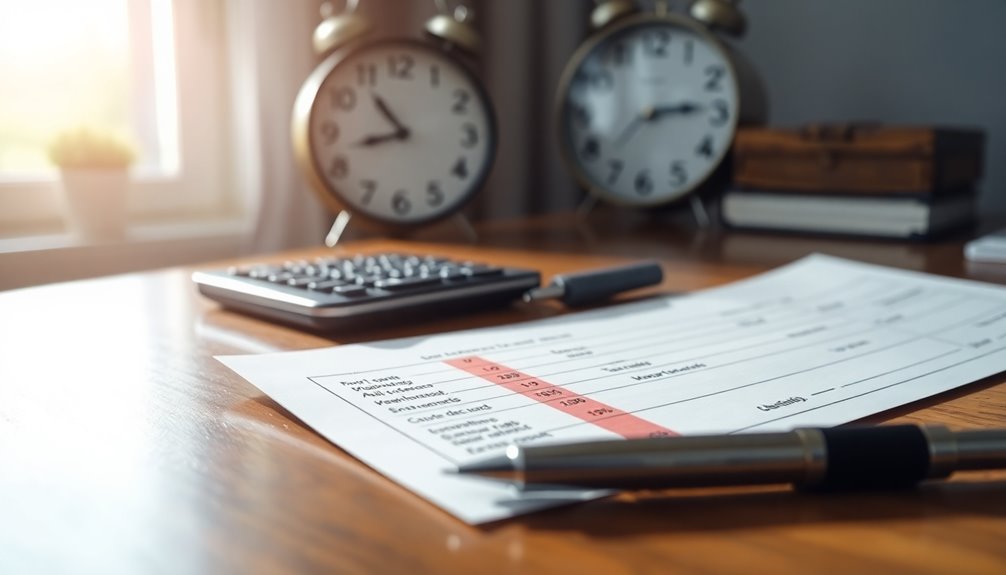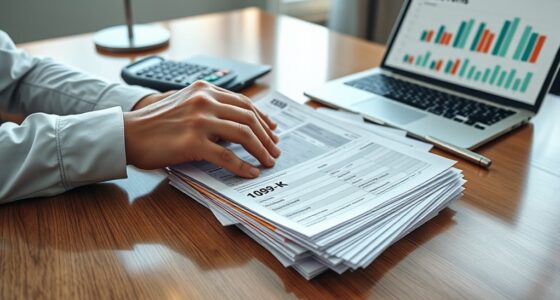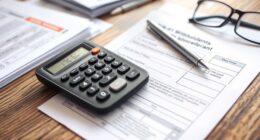To do your taxes for DoorDash, start by tracking your income and expenses carefully. You'll receive a 1099-NEC form if you earn over $600, which includes your base pay and tips. Use Form 1040 and Schedule C for reporting your income and eligible deductions, like vehicle expenses and communication costs. Don't forget about self-employment tax, which is 15.3% on your net earnings. If you owe more than $1,000, you'll need to make quarterly estimated tax payments. Keep organized records to simplify the process, and you'll find plenty more tips that can help ease your tax experience.
Key Takeaways
- Keep track of all earnings and expenses throughout the year to ensure accurate reporting on your tax forms.
- Use Form 1040 and Schedule C to report your DoorDash income and deduct eligible business expenses.
- Monitor your earnings via the Dasher app, as you'll receive a 1099-NEC if you earn over $600.
- Set aside funds quarterly for estimated taxes if your tax liability exceeds $1,000 to avoid penalties.
- Consider using tax preparation software or consulting a tax professional to optimize deductions and ensure compliance.
Understanding Tax Forms
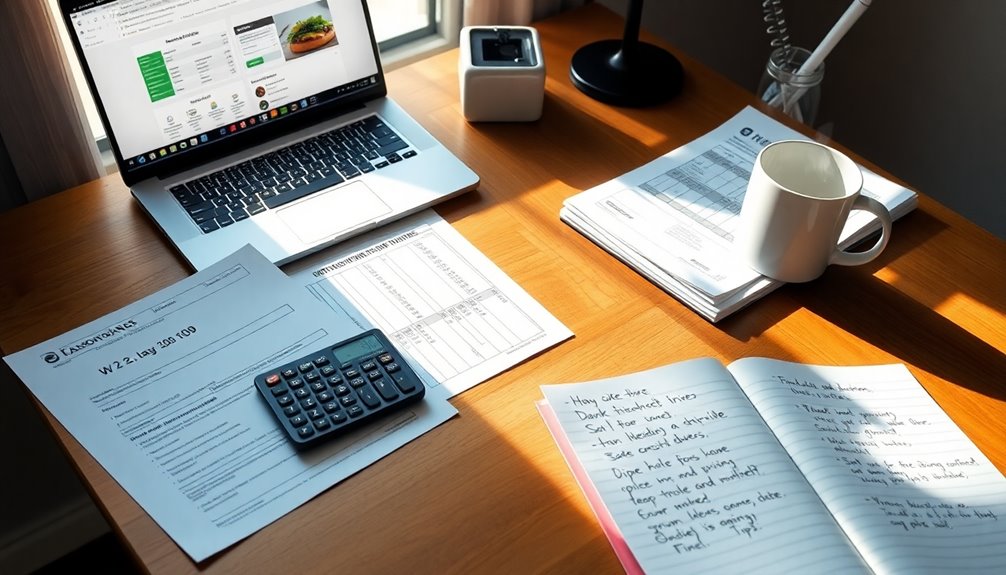
When you start driving for DoorDash, understanding the tax forms you'll encounter is crucial. One of the key forms you'll receive is the 1099-NEC. You'll get this if your earnings exceed $600 in a year. This form reports your total income from DoorDash, which includes base pay, tips, pay boosts, milestone payments, and driver referral payments.
Since 2020, the 1099-NEC replaced the 1099-MISC for nonemployee compensation, making it essential for your tax reporting. You won't receive a W-2, so it's important to track your earnings accurately. You'll need to report this income on your Form 1040, along with Schedule C for any business expenses. Familiarity with these tax documents can streamline your tax preparation process and help you avoid any issues with the IRS.
Be mindful of the tax deadlines; quarterly payments are due on April 15, June 15, September 15, and January 15, while the annual deadline is April 15 for those not required to file quarterly. The 1099-NEC forms are generally available electronically through your Stripe Express account or by paper, depending on your preference, within 10 business days after the end of the tax year.
Understanding these forms will set you up for success.
Managing Tax Obligations

As a DoorDash Dasher, it's essential to proactively manage your tax obligations since the platform doesn't withhold taxes from your earnings.
As an independent contractor, you're responsible for setting aside money for federal, state, and self-employment taxes. Remember, self-employment taxes include 15.3% for Social Security and Medicare, which you must fully cover. Federal income tax rates range from 10% to 37%, depending on your earnings, while state tax rates can vary significantly. Additionally, as an independent contractor, you must file estimated quarterly taxes if you expect to owe $1,000 or more.
If you expect your tax liability to reach $1,000 or more, you'll need to file estimated quarterly taxes by the deadlines: April 15, June 15, September 15, and January 15 of the following year.
Failing to pay these taxes can lead to penalties and interest from the IRS, and in severe cases, it may result in legal action.
To stay compliant, file your federal tax returns by mid-April, typically April 15, and pay any taxes owed on the same day.
You can utilize IRS Free File, online software, or hire a professional tax preparer. Keeping accurate records throughout the year will make this process smoother and ensure you're ready when tax season arrives.
Deductions for Business Expenses
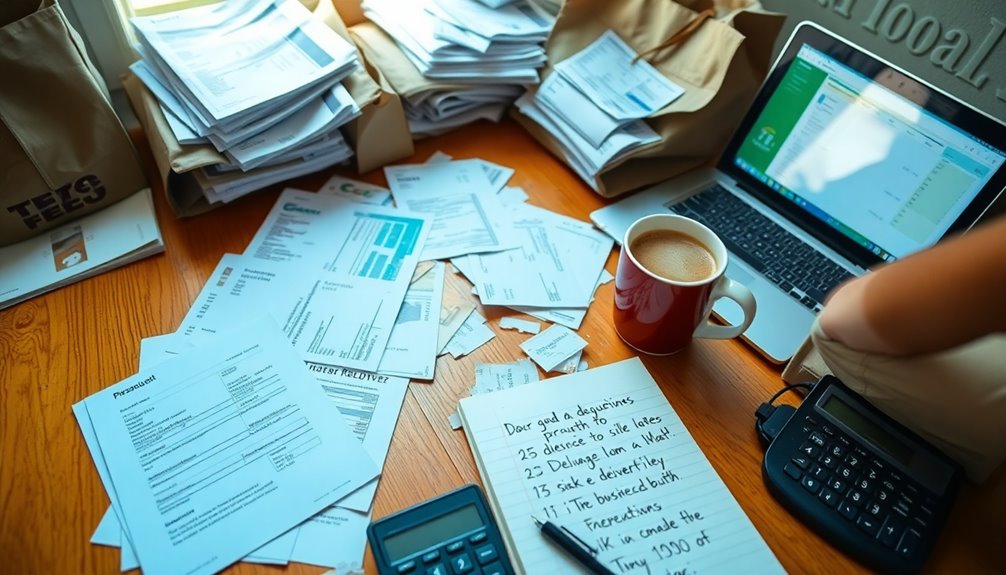
Maximizing your deductions for business expenses can significantly reduce your taxable income as a DoorDash Dasher. Start by tracking your vehicle and transportation costs. You can choose between the standard mileage deduction or deducting actual expenses like gas, maintenance, and repairs. Don't forget about parking fees and tolls—they're deductible too! Additionally, consider the impact of inflation-protected annuities on your long-term financial planning, especially if you are setting aside some of your earnings for retirement.
Next, consider your equipment, tools, and supplies. If you bought insulated bags, coolers, or delivery-related clothing like helmets, those costs can be written off. Also, keep receipts for backpacks and any bicycle accessories used for your deliveries.
Communication and service expenses are another area to explore. You can deduct a portion of your cell phone and data costs based on business use. If you use mileage tracking software or premium navigation apps, those subscriptions are also deductible. Plus, bookkeeping software fees and outsourced accounting fees can help lower your taxable income. Additionally, maintaining detailed records of your expenses will support your claims during tax filing.
Lastly, don't overlook licenses and health insurance. Any business license fees or health insurance premiums (if eligible) can be deducted.
Calculating Self-Employment Taxes

Calculating self-employment taxes can seem daunting, but understanding the process is crucial for DoorDash Dashers. The self-employment tax rate is 15.3% of your net earnings, covering Social Security and Medicare. Unlike traditional employment, you're responsible for the entire 15.3%, which applies to all your DoorDash earnings, including tips. Remember, this tax is based on net earnings, not gross.
To determine your taxable income, include all your DoorDash earnings, irrespective of receiving a 1099 form. If you earn $600 or more, DoorDash will provide a 1099-NEC form via Stripe Express. Report all income on Form 1040, ensuring you account for every tip received. Additionally, it's important to recognize that taxes are owed on all DoorDash income, regardless of 1099 issuance.
If you expect to owe $1,000 or more in self-employment taxes, you'll need to make quarterly estimated tax payments. These are due by April 15, June 15, September 15, and January 15 of the following year. Missing these payments can lead to penalties, so stay on top of them.
Keep in mind that self-employment tax is in addition to federal and state income taxes, which can significantly impact your overall tax liability. Proper planning and accurate record-keeping can help manage this burden.
Filing Your Tax Return
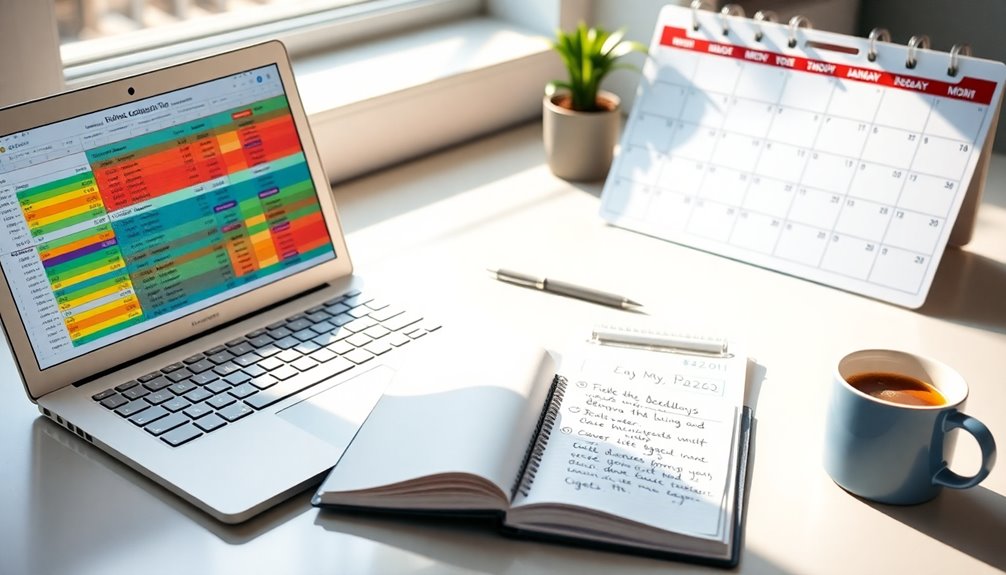
Filing your tax return is a crucial step for DoorDash Dashers to ensure compliance and potentially maximize your deductions. If you earned $600 or more in a tax year, you'll receive a 1099-NEC form from DoorDash via Stripe by January 31. This form details your non-employee compensation, including base pay, tips, pay boosts, and milestones.
Before you file, gather all necessary documentation. Collect your 1099-NEC and any additional 1099 forms from other gig platforms. Keeping accurate records of all income sources is essential for tax filing.
Don't forget to track your business-related expenses, such as mileage, tolls, parking, and supplies. If you have other employment, include any W-2 forms as well.
When it's time to file, you can choose between IRS Free File, paid online software, or hiring a professional tax preparer.
You'll need to complete Form 1040 alongside Schedule C to report your business income and expenses. Remember, federal tax returns are typically due by mid-April.
If you expect to owe $1,000 or more, you'll also need to make estimated quarterly tax payments to avoid penalties.
Navigating State Taxes
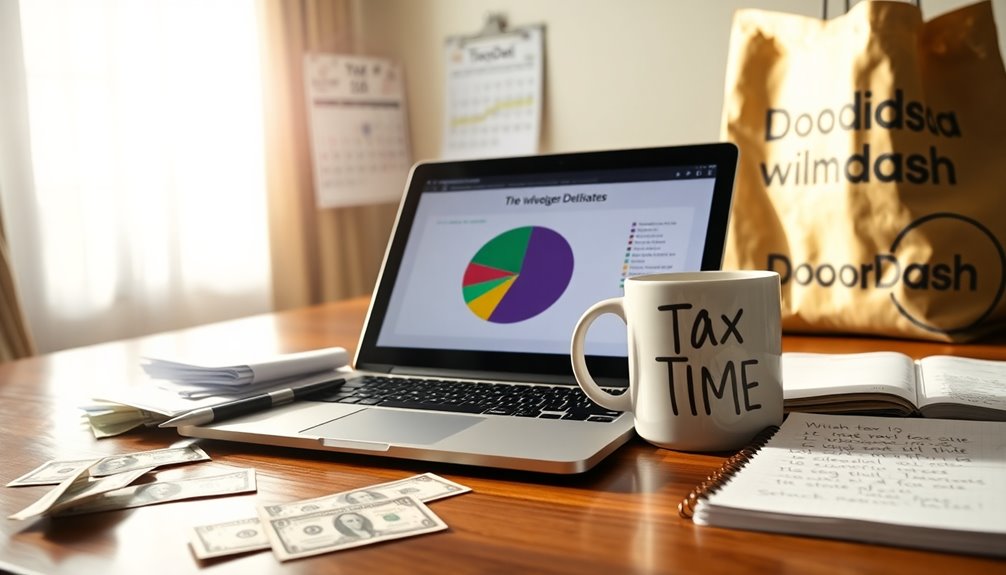
Understanding your state tax obligations as a DoorDash driver is essential for maintaining compliance and optimizing your financial situation. State tax rates can vary based on your total income, not just what you earn from DoorDash. Be aware that local and school district taxes might also apply, depending on where you live.
In states like Ohio, you can take advantage of business income deductions that may significantly reduce your taxable income. For instance, Ohio allows you to deduct up to $250,000 of business income if you're filing as 'Single' or 'Married filing jointly'. Additionally, it's important to note that marketplace facilitators like DoorDash may handle tax remittance on your behalf in certain jurisdictions.
Even if you don't owe state tax, you're still required to file a state tax return. Each state has its own tax forms and requirements for self-employment income, so familiarize yourself with those specifics.
Remember that if your total tax liability is expected to exceed $1,000, you'll need to make quarterly estimated tax payments. Lastly, be mindful of payment deadlines and potential penalties for late payments, as these can impact your overall financial health.
Stay informed to ensure you meet all obligations effectively.
Tracking Income and Expenses
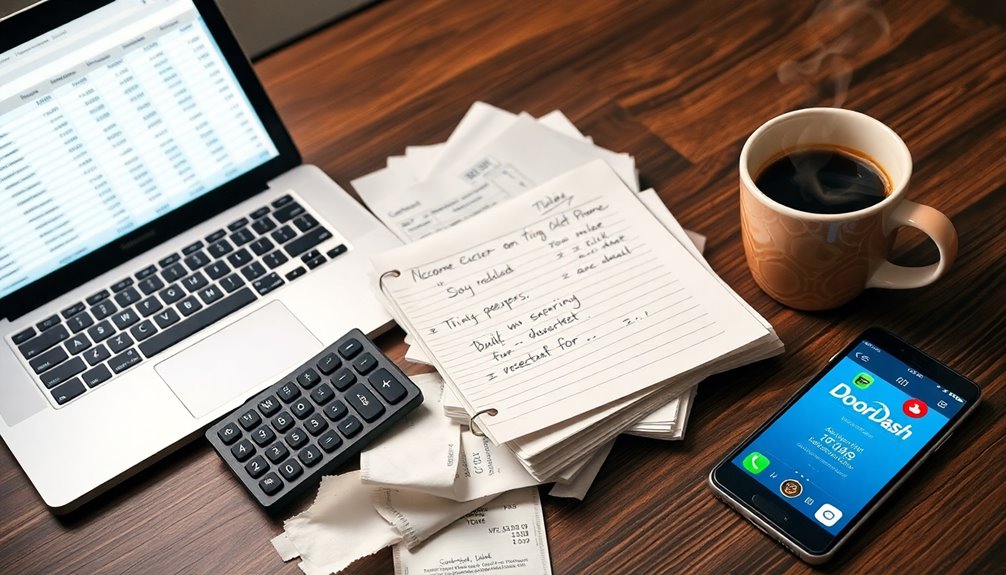
As tax season approaches, tracking your income and expenses as a DoorDash driver becomes crucial for accurate reporting and maximizing deductions. Start by monitoring your earnings closely. DoorDash sends a 1099-NEC form if you earn over $600, which reflects your total earnings, including base pay, tips, and bonuses.
Access your earnings statements through the Dasher app by tapping "Earnings" and selecting "Earnings Statements." Download these PDFs for your records.
For effective tracking, calculate your total earnings, keeping in mind any peak pay opportunities that can boost your income during busy periods. Don't forget about your quarterly estimated taxes; set aside funds based on your earnings to avoid penalties. Understanding your tax obligations as an independent contractor is vital to ensure you meet all requirements.
Tracking your business expenses is equally important. Document your mileage using apps to ensure you claim the standard rate or actual expenses. Remember, only work-related mileage is deductible.
Keep records of vehicle-related costs, like gas and maintenance, as well as other business expenses such as equipment and cell phone usage.
Maintaining organized records will make your tax filing smoother and help you maximize your deductions.
Utilizing Tax Preparation Tools

When it comes to preparing your taxes as a DoorDash driver, utilizing tax preparation tools can make the process significantly easier and more efficient. Software like TurboTax allows you to upload your 1099 forms for automatic data entry, saving you time and reducing manual input errors. These tools suggest deductions and help identify eligible write-offs, ensuring you maximize your tax savings. Additionally, understanding that keeping accurate records of tips is crucial for tax reporting can help you stay organized while using these tools.
Expense tracking is simplified with tools like Keeper, which automatically scans your transactions for business expenses. They differentiate between personal and business costs, tracking mileage, gas, and maintenance to automate filling out Schedule C.
Additionally, tax preparation software provides built-in calculators for estimating your quarterly tax payments, reminding you of deadlines to avoid penalties. It also integrates state and federal tax calculations, helping you manage self-employment taxes effectively.
If you need assistance, many programs offer live support from tax professionals. With help bars and suggestions throughout the filing process, you can navigate your taxes confidently.
Whether you're a novice or experienced, these tools can streamline your tax preparation and ensure you're compliant while maximizing your deductions.
Seeking Professional Tax Advice

Navigating taxes as a DoorDash driver can feel overwhelming, but seeking professional tax advice can simplify the process. A tax professional can clarify your specific tax obligations as an independent contractor, ensuring you understand what's required.
They'll help you maximize eligible deductions like mileage, parking, and your cell phone usage, which can significantly reduce your tax liability. Furthermore, they can assist you in understanding your responsibilities regarding estimated tax payments, which are crucial for avoiding penalties.
When you consult a tax advisor, expect a thorough review of your income and expenses, ensuring every deduction is accounted for. They'll guide you on how to handle the 1099 form from DoorDash and assist with filling out Schedule C on your federal tax return.
Additionally, they'll help you estimate and make quarterly tax payments, avoiding potential penalties for late submissions.
Choosing the right tax professional is crucial. Look for someone experienced with gig economy taxes, knowledgeable about self-employment taxes, and familiar with current IRS regulations.
Check client reviews and recommendations to ensure you're working with someone reliable. With the right guidance, you can simplify your tax process, optimize your deductions, and stay compliant with all tax deadlines.
Frequently Asked Questions
What Is the Deadline for Receiving the 1099-NEC Form?
You should expect to receive your 1099-NEC form by the end of January.
If you opted for electronic delivery, you can access it online by January 31.
Keep an eye out for an email from Stripe inviting you to set up your Stripe Express Account, as this is crucial for accessing your tax information.
If you chose mail delivery, it might take up to 10 business days after the end of January to arrive.
Can I Receive My Tax Forms Electronically?
Yes, you can receive your tax forms electronically.
To do so, you need to earn $600 or more during the tax year and sign up for e-delivery through Stripe Express.
You'll get an email invitation to enable this option.
Make sure your tax information is correct and agree to paperless delivery by mid-January.
This way, you'll have faster and easier access to your tax forms when they're ready.
How Do I Amend a Previously Filed Tax Return?
To amend a previously filed tax return, you'll need to fill out Form 1040-X.
Start by collecting your original return and any new documentation.
In the form, clearly indicate what's changed in three columns: original info, differences, and corrected amounts.
Once completed, submit it by mail or e-file if possible.
Don't forget to attach any supporting documents, and keep a copy for your records while you wait for processing.
What Should I Do if I Don't Receive My 1099-NEC?
If you don't receive your 1099-NEC, first check your email and spam folder for notifications from Stripe.
Log into your Stripe Express account to verify your tax info and ensure it's current.
If you still can't find it, contact DoorDash support for help.
Are There Penalties for Late Filing of My Tax Return?
Yes, there are penalties for late filing of your tax return.
Typically, you'll face a 5% penalty on unpaid taxes for each month you're late, up to 25%.
If you don't file within 60 days, the minimum penalty is $435 or 100% of unpaid tax, whichever is less.
Interest also accrues on unpaid taxes and penalties, so it's best to file on time to avoid these additional costs.
Conclusion
In conclusion, handling your taxes as a DoorDash driver doesn't have to be overwhelming. By understanding the necessary forms, tracking your income and expenses, and taking advantage of deductions, you can simplify the process. Don't forget to stay informed about state tax regulations and consider using tax preparation tools or seeking professional advice if needed. With a little organization and effort, you'll be able to navigate your tax obligations confidently and efficiently.

